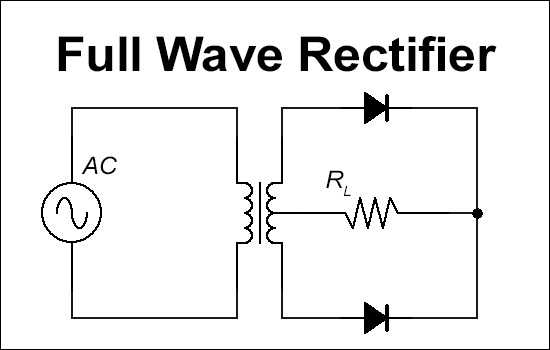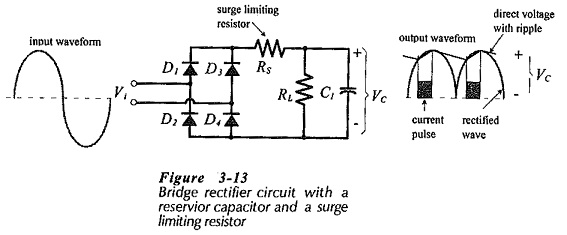
In figure 2 we inserted a capacitor across the load. Connect the same AC voltmeter across a clean DC source such as a car battery, one will read zero volts AC. This is normal as one is reading the "ripple" riding the unfiltered raw D.C.

Switch the meter to AC, one will still read a voltage of some value. Put a DC voltmeter across the load above in figure 1, one will read about 5.66 volts. Pure DC, such as from a 12 volt auto battery, has none of the "ripple" and will be a real 12 volts. But the average (or measured) voltage DC is peak times. To get peak we multiply 12.6 by 1.414, which equals about 17.8 volts. In the case above, we get very poor power transfer with the diode off during the negative half-cycle and the positive half-cycle changing constantly between zero volts and peak. See your text.) We must have voltage and current together to get power, so an open switch, broken wire, or a shut-off diode delivers no power.

(I'm not going into all of Ohm's Law here. (Electric charges) Power is voltage times current.

What is power? Voltage (in volts) is the "push" and the current (in Amperes) is what is being pushed. In the case of 60 Hertz it's 1/60 = 16.7 mSec.īuild a low voltage DC power supply Part 3 The period of a sine wave from 0 degrees to 360 degrees equals 1/F. Thus current will flow only of the positive half-cycle (0 to 180 degrees) and the diode will shut-off during the negative half-cycle from 180 degrees to 360 degrees. When the anode (A) is positive and the cathode (K) is negative current flow from positive to negative will flow through the diode, through the load, and back to the power supply. A diode is a solid-state device that conducts in one direction only. The output obtained can now be used to power electronic devices/circuits.Many devices, in particular solid state electronics, must use DC or direct current. So a filter capacitor C1(1uF) is connected across the output of the rectifier so as to bypass the AC component present in it. The bridge rectifier rectifies the stepped down AC to pulsating DC which contains ripples. Here, four 1N4007 diodes (D1-D4) have been used as shown in the circuit diagram. Almost all rectifiers comprise a number of diodes in a certain arrangement for converting AC to DC than is possible with only one diode.

Therefore the signal is rectified using a bridge rectifier to block the negative portion of the waveform. This AC signal has alternating positive and negative waveform cycle while the desired output should always be positive. The reduced voltage level (12V) appears on the secondary winding of the transformer. This is achieved here by using a step down transformer 12-0-12V of 500mA rating. Peak voltage across the load is matched to the peak value of AC voltage from output of a transformer. In this project, the input mains supply is stepped down from 230 V AC to a desired level (depending upon the rating of the load connected). While the diodes act as actifiers, capacitor filters out the DC component from the circuit. The resulting signal is then filtered to get the DC output. The major part of the circuit is connected to the secondary coil of the transformer which is comprised by diodes and capacitor. This AC supply is then passed through a rectifier circuit to remove the negative cycle of AC waveform. Firstly, the AC input from mains is stepped down to a lower value of voltage. A simple rectifier circuit described in this project converts the input from AC source to DC voltage. An AC power source is required for powering major appliances but almost all electronic circuits require a steady DC supply.


 0 kommentar(er)
0 kommentar(er)
